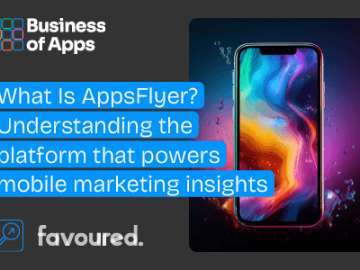GamesBeat is excited to partner with Lil Snack to have customized games just for our audience! We know as gamers ourselves, this is an exciting way to engage through play with the GamesBeat content you have already come to love. Start playing games here.
Mobile app ad data platform AppsFlyer released its annual report on the mobile gaming market, including trends in monetization, differences between iOS and Android and user acquisition. Uniquely, the firm’s report uses anonymized and aggregated data from 15,000 gaming apps with at least 3,000 non-organic installs per month rather than a more estimates-driven approach.
AppsFlyer’s report provides insights into the mobile gaming market’s modest growth in recent years as well as benchmarks for app developers, marketers and game studios.
“The paradigm shift that we see in this report has not only blurred the boundaries of how gaming apps are bringing in revenue, but has also crafted a market that thrives on nuance and adaptability. This transformation signifies a substantial recalibration impacting the entirety of mobile gaming,” said Adam Smart, direct of product, gaming at AppsFlyer. “For marketers looking to capitalize on the current market, not putting too many eggs in one basket is the right way to go. With Cost Per Installs (CPIs) down on iOS, meaning the time to benefit from the lowest cost of media that can be exploited, and Android posting positive results across several indicators such as installs and [non-organic installs], the future of growth will be around diversifying.”
User Acquisition trends
AppsFlyer detailed how user acquisition spending varied in 2023 across markets, genres and platforms.
Lil Snack & GamesBeat
GamesBeat is excited to partner with Lil Snack to have customized games just for our audience! We know as gamers ourselves, this is an exciting way to engage through play with the GamesBeat content you have already come to love. Start playing games now!
The U.S. is the most competitive mobile market on both iOS and Android.
The U.S. remains the most competitive market for user acquisition by far. Last year, app developers spent $12.2 billion to acquire new U.S. users, accounting for over 40% of the $29 billion in global UA ad spend. In comparison, the next most sought after markets, Japan and South Korea, accounted for $3 billion and $1.5 billion respectively. Alone, the U.S. accounted for more UA spend than the other top 10 markets combined.
 Match games dominate ad spend to acquire new users.
Match games dominate ad spend to acquire new users.
In terms of genres, developers spent the most to acquire new players for match games on mobile. The genre accounted for $8.65 billion — about 30% — of global mobile UA spend. This was followed by strategy ($4.57 billion), RPG ($3.84 billion), casino ($2.72 billion) and simulation ($2.03 billion) titles. Together, these top five genres account for roughly 25% of all spending.
Compared to previous years, casual games saw a 13% rise in non-organic installs (NOIs) and ad spend. Likewise, simulation and action titles saw significant growth in these metrics. Despite being the second and third highest spending genres, RPGs and Strategy games saw declines in these metrics.
 The difference between Cost per Install (CPI) on iOS and Android is narrowing.
The difference between Cost per Install (CPI) on iOS and Android is narrowing.
Of course, the platform differences between iOS and Android play a key role in user acquisition — among other trends. In 2023, ad placement costs fell 17% on iOS and rose 48% on Android, however Cost per Install (CPI) is still much higher on iOS overall. In 2023, CPI hovered around $6.80 on iOS and $1.35 on Android. Meanwhile in Q2 2023, CPIs totalled $5.46 on iOS and $2.17 on Android. To AppsFlyer, this signals increased efficiency for developers looking to acquire new iOS users.
Changing monetization strategies
AppsFlyer’s data also shows that the division between revenue strategies for Hyper Casual and mid-core games is blurring. Traditionally, hyper casual titles relied on monetizing users through in-app advertising (IAA) while their mid-core counterparts focused on in-app purchases (IAP).
 Mobile games are trending towards blending IAA and IAP.
Mobile games are trending towards blending IAA and IAP.
Now, a hybrid model that blends IAA with IAP is on the rise. This year, 43% of games used a hybrid monetization model — up from 36% of games in 2023. In fact, roughly the same number of games use a hybrid model as use an IAA only model compared to an 11-point gap in the same quarter of 2023.
Of course, both sides have their reasons for adopting monetization strategies from the other genre. For hyper casual titles, Apple’s App Tracking Transparency (ATT) changes have reduced data availability, leading to less IAA revenue and more difficulty finding high-value users or “whales.” Meanwhile, mid-cores are incorporating IAA to make up for the stagnating growth of IAP. These titles have also benefited from less intrusive ad formats, reducing the retention hurdle ads once posed.
If developers do plan to use in-app purchases, they should plan on a small percentage to convert to paying users — typically, only 5%. However, payers are likely to be repeat buyers with about 70% making second purchases.
 AppsFlyer shows how crucial it is for mobile devs to monetize users early.
AppsFlyer shows how crucial it is for mobile devs to monetize users early.
AppsFlyer pointed out how critical the first week is to convert players into payers. On both iOS and Android, about 50% of lifetime payers will buy something within the first three days.
AppFlyer’s full report is available now.
GB Daily
Stay in the know! Get the latest news in your inbox daily
Thanks for subscribing. Check out more VB newsletters here.
An error occured.





